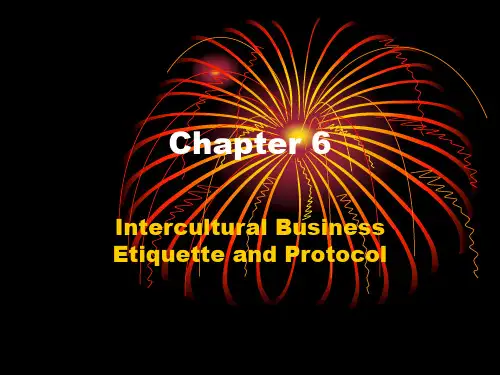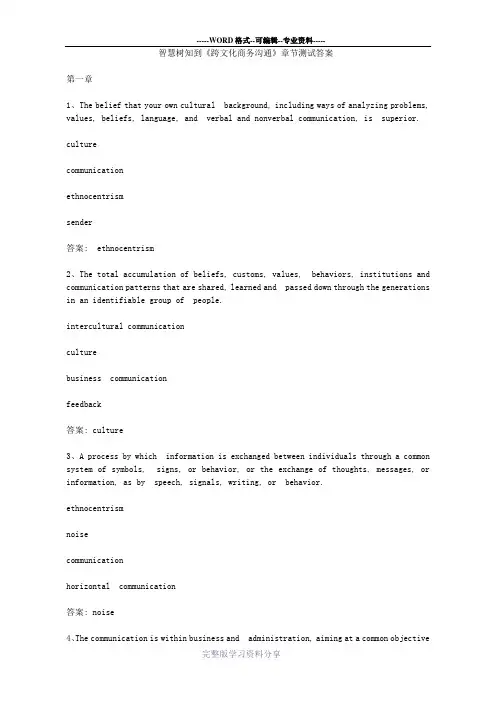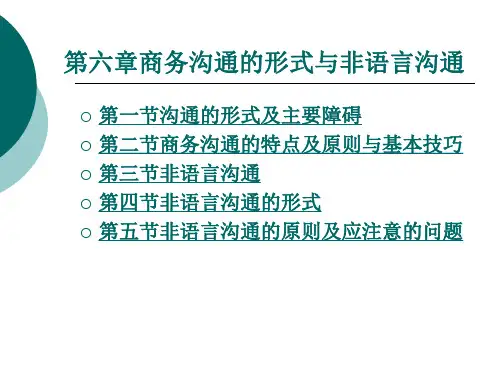跨文化商务沟通第06章
- 格式:ppt
- 大小:496.00 KB
- 文档页数:48





跨文化商务沟通复习资料第一章一.文化适应的四个维度P9Dimensions of AcculturationIntegration - persons become an integral part of the new culture while maintaining their cultural integritySeparation - individuals keep their culture and stay independent of the new culture Assimilation - persons are absorbed into their new culture and withdraw from their old cultureDeculturation - individuals lose their original culture and do not accept the new culture第二章不作为考试重点第三章一.不同文化的人们对待女性,道德标准以及工作的态度不同P47~P56①Attitudes Toward Women:Influenced by cultural roots;U.S. women are supposed to have the same rights as men;Kenya women are considered subordinate to men;Gender differences in the U.S. workplace are de-emphasized - women are accepted at higher levels in government and in many companies;U.S. women have taken two-thirds of new jobs created; they are starting new businesses at twice the rate of men;In France, one-fifth of small businesses are owned by women; in Canada, the rate is one-third;The U.S. and Canada lead the world in the number of women in executive positions; Northern and Western Europe, Australia, and New Zealand also have high numbers of women managers.Percentage of Women in Top Management Positions:The Russian Federation 42%,European Union 30%,Australia 23%,United Kingdom 21%,United States 20%,Japan 7%.②Cultural Attitudes Toward Work:Work ethic - hard work is applauded and rewarded; not working is viewed negatively. U.S. persons value work; executives work-56 hours per week.-take 14 days of vacation a year.European persons work-36 to 41 hours per week.-take 4 to 6 weeks of vacation a year.Europeans:Relaxed;Vacation during month of August;Do not work weekends or holidays (The French take longer vacations than people of any other country.) Australians:Value free time; Value short work weekJapanese :Work Monday through Friday, often 18 hours a day;Work until their boss leaves③Attitudes Toward Ethics:Ethical behavior means acting with integrity, honesty, competence, respect, fairness, trust, courage, and responsibility.Ethical standards are guidelines established to convey what is perceived to be corrector incorrect behavior by most people in a society.Ethics: The Four-Way Test:Is it the truth?Is it fair to all concerned?Will it build goodwill and better friendships?Will it be beneficial to all concerned?二.个人主义和集体主义P57Individualism - attitude of valuing ourselves as separate individuals with responsibility for our own destinies and actions.Collectivism - emphasizes common interests, conformity, cooperation, and interdependence.第四章一.文化冲击的阶段P69Stages of Cultural Shock:Stage 1: Excitement and fascination with the new culture; the "honeymoon" stage. Stage 2: Crisis or disenchantment period; excitement has turned to disappointment. Stage 3: Adjustment phase; you begin to accept the new culture, try new foods, see the h umor in situations.Stage 4: Acceptance or adaptation phase; feel at home in the new culture and become involved in activities of the culture.Stage 5: Reentry shock; follows the stages identified earlier: initial euphoria, crisis or disenchantment, adjustment, and adaptation.二.如何缓解文化冲击P71~P74To alleviate cultural shock, try to see the environment from the perspective of the host nationals.①慎重挑选外派人员Alleviating Cultural Shock by Careful Selection of Overseas Personnel(Sensitive, cooperative, able to compromise;Open to others' opinions;Reaction to new situations; appreciation of cultural differences;Understanding of own values and aware-ness of values in other cultures;Reaction to criticism;Understanding governmentsystem;Ability to develop contacts in new culture;Patience and resiliency.)②提供出国前培训Intellectual or classroom model - involves giving facts about the host country using a variety of instructional methods;Area training or simulation model - emphasizes affective goals, culture specific content, and experiential processes;Self-awareness or human relations model - based on the assumption that the trainee with self-understanding will be more effective in the overseas assignment;Cultural awareness model - emphasizes cultural insight and stresses affective goals and an experiential process;Interaction approach - participants interact with people in the host country; Multidimensional approach - attempts to combine cognitive, affective, and behavioral aspects of training;③提供反馈和奖励Reward systems include special allowances for housing, hardship, home leave, medical, taxes, etc.Appraisal and reward system must reflect the purpose and expectations of theassignment (profit or building a presence in the country).Reward system must compensate for what persons are leaving behind and must be based on the idea of equity④发挥员工的最大潜力Developing Employees to Their Potential:Plan for repatriation, including reasons for the assignment and how the employee will contribute to the company upon his/her return.Allow adequate time for readjustment before employee reports to work.Provide appropriate compensation for transition expenses.Assist in locating proper housing.Show appreciation to family for their contributions.第五章一.高语境和低语境的语言P86High-Context Language 特点:Low-Context Language 特点:二.线性语言和非线性的语言P90Linear Language:Has a beginning and an end;Is logical;Is object oriented;Linear languages look at time on a continuum of present, past, and future (English).Nonlinear Language:Is circular;Is tradition oriented;Is subjective;Nonlinear languages view time asLow Context -Get down to business first -Value expertise and performance -Agreement by specific, legalistic -contract -Negotiates as efficiently as possible High Context -Establish social trust first -Value personal relations and goodwill -Agreement by general trust -Negotiations slow and ritualistic -Nonverbal; cultural aspects are important-Language transmits little of explicit messageExample: Japanese language Chinese language-Restricted code - speech coding system of high-context languages; spoken statement reflects the social relationship-Message is explicit-May be given in more than one way to assure understanding-Very direct and verbalExample: U.S. English (high-context language viewed as a waste of time) Example: Spanish language-Elaborated code - speech coding system of low-context languages; verbal elaboration is necessary due to few shared assumptionscyclical and seasons as ever-repeating pattern (Chinese and Japanese).三.寓言和谚语P92四.语言的性质P94How Languages Differ①②①Syntactic Rules – arrangement of words in a sentence. Subject, verb, object can be combined in six possible ways. English follows mainly a subject-verb-object order (as do French and Spanish). Japanese and Korean have the preferred order of subject-object-verb. Hebrew and Welsh follow verb-subject-object. The object does not come first in any language.②Meanings - Denotative (Japanese Spider Crab), Connotative (Alaskan King Crab), and Figurative (kicking the bucket)Variations in Verbal Style①②③④⑤⑥(了解)①Japanese Verbal Style:The Japanese converse without responding to what the other person says. Emphasis is on nonverbal communication so they do not listen.They prefer less talkative persons and value silence.The Japanese prefer a person say something in as few words as possible.They make excuses at the beginning of a talk for what they are about to say. They do not want apologies for was already said.They use “yes” to mean many different things.②Mexican Verbal Style:The Mexican style seems overly dramatic and emotional by U.S. persons.Mexicans rise above fact; they embellish facts; eloquence is admired.They like to use diminutives, making the world smaller and more intimate.They add suffixes to words to shrink problems. Mexicans come across as less than truthful.Their rationale involves two types of reality - objective and interpersonal. Mexicans want to keep people happy for the moment. When asked directions, if they do not know the answer, they will make up something to appear to be helpful.③Chinese Verbal Style:The Chinese understate or convey meanings indirectly. They use vague terms and double negatives. Even criticism is indirect.Harmony is very important. During negotiations, the Chinese state their position in such a way that seems repetitious.They do not change their point of view without discussing it with the group.They speak humbly and speak negatively of their supposedly meager skills and those of their subordinates and their family.④Verbal Styles in the Arab World:The Arabs encourage eloquence and “flowery” prose. They are verbose, repetitious, and shout when excited.For dramatic effect, they punctuate remarks with pounding the table and making threatening gestures.Arabs view swearing, cursing, and the use of obscenities as offensive.They like to talk about religion and politics but avoid talking about death, illness, and disasters. Emotional issues are avoided.The first name is used immediately upon meeting but may be preceded by the title “Mr.” or “Miss.”⑤German Verbal Style:In the German language, the verb often comes at the end of the sentence. In oral communication, Germans do not get to the point right away.Germans are honest and direct; they stick to the facts. They are a low-context people; everything is spelled out.Germans usually do not use first names unless they are close friends (of which they have few).They do not engage in small talk; their conversations are serious on a wide variety of topics. Avoid conversations related totheir private lives.⑥Language Variations in the U.S.Age - some word s are specific to an age group (“cool”).Gender - men speak more, they repeat more, and more often than women; women are more emotional and use such terms as “sweet,” “darling,” and “dreadful.”Race - Black English includes such terms as rapping (a narration to a musical beat). Regional Variations - distinctive language patterns exist between various parts of the United States.五.语言和文化的相互影响 P102Sapir-Whorf Hypothesis - The main idea is that language functions as a way of shaping a person’s experience, not just a device for reporting that experience. Both structural and semantic aspects of a language are involved.Linguistic determinism is the assumption that a person’s view of reality stems mainly from his or her language. Ex: The absence of the word snow in Inuit, the language of the Eskimo people. The language does, however, have numerous words for types of snow, while other languages do not have the equivalent of flaky snow or crusty snow.Bernstein Hypothesis - explains how social structure affects language and is an extension of the Sapir-Whorf Hypothesis. Bernstein considers culture, subculture, social context, and social system to be part of social structure. Speech emerges in one of two codes - restricted or elaborated. Channels used in the restricted code would be oral, nonverbal, and paralinguistic. Restricted codes would include highly predictable messages. Elaborated codes are used with strangers; involve messages that are low in predictability. Give very explicit information. The verbal channel is important in elaborated codes, while restricted codes make use of nonverbal and paralinguistic cues.第六章看案例第七章不考第八章一.电子通讯礼仪P157Electronic Communication EtiquetteWhen communicating by telephone, the initial impression is formed more on vocal quality than on words spoken.Good telephone manners include answering the phone promptly, identifying yourself properly, and being courteous at all times.When using voice mail, be brief but complete when leaving a message.When using e-mail, avoid negative or personal information.Proper netiquette avoids the following:shouting - typing the message in all capital lettersdissing - speaking ill of someoneflaming - sending vicious, insulting messagesspamming - mass mailings of commercial advertisements or material cross-posted to numerous newsgroups.二.小费文化P160Tipping:People communicate nonverbally by their tipping practices; those who are basically stingy and those who are basically generous will reveal these traits by their tipping behavior.“Insult tipping” (leaving a few coins) shows a lack of breeding and is always inappropriate.Although a tip of 15 percent of the bill used to be considered a generous tip in fine restaurants, 20 percent is now closer to the norm when the service is excellent.第九章特色食品和饮食禁忌P187Unusual Foods:特色U.S. - corn-on-the-cob, grits, popcorn, marshmallows, crawfishSouth Korea - dog meatSaudi Arabia - sheep's eyeballsMexico - chicken's feet in chicken soupChina - duck's feetRussia - Danish pastry stuffed with raw cabbageSome African countries - gorillaConsumption Taboos:禁忌U.S. - horse meat and dog meatStrict Muslims - pork and alcoholOrthodox Jews - pork, shellfish, meat, and milk togetherHindus - beef。

新媒体时代的跨文化商务沟通跨文化商务沟通课后答案【摘要】在商务活动中,拥有不同文化背景的人们通过某种特定的媒介相互传递着信息、思想、知识以及情感,这一过程被称为跨文化商务沟通。
新媒介与新技术的不断涌现,通过沟通媒体进行的跨文化商务沟通也因新媒体的介入进入了全新的时代。
新媒体的介入使得跨文化商务沟通呈现出新的特点。
【关键词】新媒体;跨文化;商务沟通一、跨文化商务沟通与媒体在商务活动中,拥有不同文化背景的人们通过某种特定的媒介相互传递着信息、思想、知识以及情感,这一过程被称为跨文化商务沟通。
?譹?訛随着经济全球化趋势的日益明显、国际商务活动的日益频繁,现代企业跨国经营中越来越显示出对多元文化理解的必要性和跨文化沟通的重要性。
可以说,跨文化商务沟通意味着直接的经济效益。
一个企业要想使自己的产品在国际市场上占有一席之地,一个跨国公司想在其他国家或地区取得经济效益,那就不仅需要具备雄厚的经济实力、发达的专业技术和高超的管理水平,而且需要深刻了解对象国的文化,建立起一套成熟完善的商务沟通体系,用以消除文化误解、化解文化冲突,来保证企业行为的顺利进行以及实现企业利益的最大化。
作为现代企业行为中一个至关重要的环节,商务沟通是通过媒体来实现的。
媒体是在传播者和接受者之间进行信息传递的工具。
不同媒体的使用决定了商务沟通不同的表现形式:口头沟通、书面沟通、网络沟通和非言语沟通等等。
传统的商务沟通媒体多为电话、电子邮件、信件、报告及面对面的交谈等形式。
不论是企业内部的共享信息、协调活动、感情交流,还是企业之间的信息收集、资源共享、协同合作,商务沟通都扮演着企业经营管理中不可替代的角色。
特别是随着现代经济活动国际化程度的加深,跨文化管理成为商务活动的重要内容,文化差异所带来的文化冲突要经过日常的文化交流与思想沟通才能消除。
跨文化商务沟通通过各种沟通媒体,克服文化隔阂产生的矛盾,解决文化差异,防止文化冲突,在企业跨文化经营管理中发挥着不可或缺的重要作用。

智慧树知到《跨文化商务沟通》章节测试答案第一章1、The belief that your own cultural background, including ways of analyzing problems, values, beliefs, language, and verbal and nonverbal communication, is superior.culturecommunicationethnocentrismsender答案: ethnocentrism2、The total accumulation of beliefs, customs, values, behaviors, institutions and communication patterns that are shared, learned and passed down through the generations in an identifiable group of people.intercultural communicationculturebusiness communicationfeedback答案: culture3、A process by which information is exchanged between individuals through a common system of symbols, signs, or behavior, or the exchange of thoughts, messages, or information, as by speech, signals, writing, or behavior.ethnocentrismnoisecommunicationhorizontal communication答案: noiseand profits for both the individuals and organizations.lateral communicationethnocentrismbusiness communicationintercultural communication答案: business communication5、The communication at the same level in an organization.horizontal communicationethnocentrismbusiness communicationlateral communication答案: horizontal communication6、When culture is contrasted with nature, it can be defined as “ life way of a population” in its broad sense, meaning what characterizes the particular way of life of a population.对错答案: 错7、Cul ture is all men’s medium; there is no aspect of human life that is not touched and altered by culture.对错答案: 对8、The culture shown in an onion consists of two levels; a level of norms and values, or an invisible level of resultant behavior or artifacts of some form.错答案: 错9、Culture cannot be known without a study of communication, and communication can only be understood with an understanding of the culture it supports.对错答案: 对10、In the global village, neighbors communicate free of troubles and difficulties.对错答案: 错11、With the integration of language into the fabric of culture, confusion and dysfunction would reign and the culture would fail.对错答案: 错第二章1、A good mastery of grammar of one language can guarantee a successful communication.对错答案: 错2、Long before writing was developed,we learned to speak first.对答案: 对3、There should always be an attachment at the end of a business memo.对错答案: 错4、A recommendation report is to recommend something to others.对错答案: 错5、Which is not verbal communication?Chat with your leaders and colleaguesDiscuss an issue in a groupGreeting with a smileLeave a message答案: Greeting with a smile6、____ refers to anything that distorts the message the source encodes.NoiseMessageSourceContext答案: Noise7、It is a universal truth that language is by culture and in turn it __ culture.influenced, reflectsdisplayed, influencesdetermined, reflectsshaped, influences答案: influenced, reflects8、Why should we take notes during a business call?Listen attentivelyServes as a record to take follow-up actionReport on the call to someone elseReflect on the call答案: Listen attentively,Serves as a record to take follow-up action,Report on the call to someone else9、How can you identify your audience in preparing a business presentation?AgeAppearanceInterestOccupation答案: Age,Interest,Occupation10、Before making a business call, what kind of questions can you reflect?Do you need to report to your boss?Do you need to get information?Do you want to sell something, or convince the person of an idea?Do you need to ask for the person’s help or support?person of an idea?,Do you need to ask for the person’s help or support?第三章1、Nonverbal behavior reflects the speaker’s subconciousness.对错答案:A2、Depending on the culture,a smile can indicate joy and amusement, it can also indicate embarrassment.对错答案:A3、Posture is the position in which you hold your body when standing or sitting.对错答案:对4、Intimate distance is most common when friends, old classmates, acquaintances and relativestalk.对错答案:错5、People in __ cultures usually view silence as lack of communication and are generally ____ with it.low context uncomfortablehigh context uncomfortablehigh context comfortable答案:low context uncomfortable6、Which of the following countries uses high-context language?CanadaGermanyJapanUnited States答案:Japan7、The function of nonverbal signs is sometimes indispensible. For example, placing your index finger to your lips as an alternative to saying “Please calm down so that I can speak” is a case of ____.complementingrepeatingcontradictingsubstituting答案:substituting8、Which statements are correct about nonverbalcommunication?Nonverbal behavior is easily controlledA smile sometimes doesn’t mean a sincere smileNonverbal behavior accounts for much of the meaning we derive from conversation.Nonverbal communication is more than the complement of verbal communication.答案:9、How does nonverbal behavior control the pace or flow of communication?Gesture of stoppingClap handsRaise voice答案:Be silent Gesture of stopping Clap hands Raise voice10、Which of the countries belong to individualistic culture?ItalyAmericaFranceGreece答案:Italy America France第四章1、Power distance is a conceptual was developed by Hofstede to describethe extent to which the less powerful members of organizations and institutions accept and expect that power is distributed unequallythe power of multinational organizationsthe power differential between developed and less developed countriesthe power difference between men and women答案:2、Hofstede’s _ index measures the extent to which the less powerful members of organizations and institutions (like the family) accept and expect that power is distributed unequally.value orientationcultural dimensionscultural valuespower distance答案:power distance3、These are the most significant studies of cultural values except ___.Hall's High- and Low- Context TheoryKluckhohn and Strodtbeck's five Value OrientationsFons Trompenars’s model of culture with seven dimensionsGeert Hofstede's six Cultural Dimensions答案:Fons Trompenars’s model of culture with seven dimensions4、The opinion that everyone has a position and clearly defined privileges is____.a view of hierarchical structure of social relationshipa view of group orientation of social relationshipa view of individual orientation structure of social relationshipnone of the above答案:a view of hierarchical structure of social relationship5、Low-context communication is characterized by explicit speaking.对错答案:对6、Chinese culture is high-context in comparison to western culture.对错答案:对7、Cultures with a large power distance are hierarchical cultures.对错答案:对8、At the core of uncertainty avoidance is the idea that the future is predictable.对错答案:错9、Power distance in Hofstede's cultural dimensions is roughly similar to the value Kluckhohn calls hierarchy.对错答案:错10、In a culture emphasizing masculinity, it is more possible for men to play a nurturing role.对错答案:错第五章1、Etiquette is simply showing respect for others.对错答案:错2、Etiquette refers to the guideline for knowing how to behave appropriately in all situations.错答案:A3、Kiss greeting usually happen between two men in the United States.对错答案:错4、It’s OK to write on someone’s business card.对错答案:B5、A handshake should be friendly or respectful gesture, not a show of physical strength. So we should not squeeze other’s hand too hard.对错答案:A6、Before a dish is served, napkins can be placed either on the plate or on the left of forks.对错答案:A7、You’re invited to a business dinner. When do you take your napkin from the table and place it on your lap?Open it immediately.Wait for the host to take his or her napkin before taking yours.Wait for the oldest person at the table to take his or hers.Wait for all the ladies to take theirs before taking yours if you are a gentle man.答案:Wait for the host to take his or her napkin before taking yours.8、Which of the following behavior is appropriate in a business dinner?Use the napkin to wipe your nose.Cut all the food in your plate into small pieces.Sip from the side of the spoon when eating soup.Use the knife with your right hand.答案:CD9、What are the benefits of humor in the workplace?Humor can reduce stress.Humor can block negative emotions.Humor can help people develop rapport with each other.Humor can help solve problems.答案:ABCD10、In many Asian countries, the way you treat someone’s business card is a reflection of:How serious you are about the outcome of the meeting.How much you respect them as a person.What you think of their country.company and title.答案:ABCD第六章and a potential cause of shame to the group.对错答案:A2、Whether an international business negotiation succeeds or not is not only determined by the strategies and skills used in formal negotiation, but also closely related to whether enough careful preparation has been made.对错答案:A3、In the opening phase, the atmosphere is the only factor we should consider.对错答案:错4、Bargaining strength refers to the degree of movement that is possible for each party with respect to individual issues on the agenda.对错答案:错5、In some Asian cultures, they will use communication to encourage harmony, preserve face, and develop ____ relationships.Short-termLong-termMiddle-termShort run答案:Long-term6、The purpose of bargaining is to settle the differences that stand in the way of an agreement. Settling the differences involves____.high-context and low-contextconcession andreappraisaladjustment and compromiseaims and objectives答案:adjustment and compromise7、The proposal should be based on a sound analysis of the buyer’s current situation, taking into account of ____ and ____ within which the transaction takes place.the commercial circumstances, the overall contextthe corporate credit, the bank accounting bookthe manager’s stability, the site selectionthe commercial invoice, the chief negotiator’s ability答案:the commercial circumstances, the overall context8、Differences in____, ____, and____ have a profound impact on how successfully the parties are able to negotiate or conduct business transactions.BehavingWays of thinkingManaging conflictHuman resources答案:9、The political system,____, and the counterpart may in some way determine the success or failure of the negotiation.The legal systemThe business systemThe financial systemInfrastructure and logistics system答案:ABCD10、The specific tasks of the opening phase are concluded: To explain the concrete issueTo create suitable atmosphereTo state proposal in opening phaseTodeclare for our intention。




跨文化商务交际教材跨文化商务交际是指在不同文化背景下,通过有效的沟通手段进行商业交流的过程。
这种交流可能是不同国家之间的商务活动,也可能是同一国家内不同文化背景的个人或组织之间的交流。
在全球化日益加速的今天,跨文化商务交际变得越来越重要。
由于不同文化背景下的价值观、商务习惯、法律法规等方面存在差异,如果不进行有效的跨文化商务交际,可能会导致误解、冲突甚至商业失败。
跨文化商务交际的核心是文化差异的管理。
这需要了解和尊重不同文化背景下的商务习惯、价值观和行为方式,通过有效的沟通手段来减少误解和冲突,实现商业目标。
在跨文化商务交际中,语言沟通和文化敏感性是非常重要的因素。
同时,还需要了解不同国家的法律法规、市场环境、消费者需求等方面的信息,以便更好地适应和开展商业活动。
此外,在跨文化商务交际中,还需要注意以下几个方面:建立信任关系:在跨文化交流中,建立信任关系非常重要。
这需要遵守商业道德和法律法规,同时通过诚实、透明的沟通建立互信关系。
了解文化差异:了解和尊重不同文化背景下的价值观、商务习惯和行为方式,可以帮助避免误解和冲突。
使用合适的语言:语言是跨文化商务交际中的重要工具。
使用合适的语言可以减少沟通障碍,提高沟通效率。
灵活应对:在跨文化商务交际中,可能会遇到各种不可预见的情况。
灵活应对可以帮助避免尴尬或冲突。
持续学习和适应:跨文化商务交际是一个持续学习和适应的过程。
通过不断学习和改进,可以提高跨文化商务交际的能力和效果。
教材是教学活动中所使用的资料,是教师传授知识的工具,是学生获取知识的源泉。
它包括教科书、讲义、参考书等。
教材是经过专家学者反复推敲、实践检验后才编写的,具有科学性、系统性和实践性等特点。
通过教材,学生可以系统地学习各种基础知识和基本技能,提高自己的综合素质和能力。
教材的编写和使用都应当遵循一定的原则。
首先,教材要符合国家的教育方针和教育规律,能够全面地提高学生的素质和能力。
其次,教材要注重实践性和实用性,能够帮助学生解决实际问题。